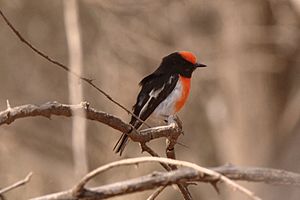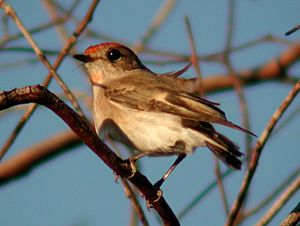Red-capped robin facts for kids
Quick facts for kids Red-capped robin |
|
|---|---|
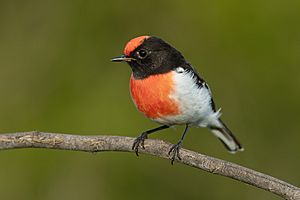 |
|
| Adult male, New South Wales | |
| Conservation status | |
| Scientific classification | |
| Genus: |
Petroica
|
| Species: |
goodenovii
|
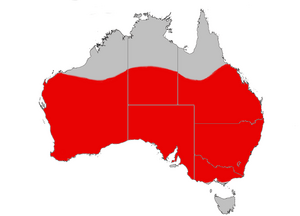 |
|
| Red-capped robin range | |
The red-capped robin (Petroica goodenovii) is a small passerine bird, meaning it's a type of songbird. It lives in Australia and is known for its bright colors. You can find it in dry areas like scrubland and open woodland.
Like many colorful robins in its family, Petroicidae, the red-capped robin shows sexual dimorphism. This means males and females look different. The bird is about 10.5 to 12.5 centimeters (4.1 to 4.9 inches) long. It has a small, thin, black beak, dark brown eyes, and dark brown legs.
Male red-capped robins are easy to spot with their bright red cap and red chest. They have black upper parts and a black tail with white tips. Their belly and shoulders are white. Females, however, are mostly grey-brown and not as colorful.
These robins sing different songs. Males usually sing to mark their territory and to attract females. You might see them alone, in pairs, or in small groups. They mostly eat insects and spiders, which they find on the ground. Even though they are found across a wide area, they are not very common in some places. Human activities have caused their numbers to drop in certain regions.
Contents
About the Red-capped Robin
What is a Red-capped Robin?
The red-capped robin was first described in 1827 by two scientists, Nicholas Aylward Vigors and Thomas Horsfield. They found it in the northern Spencer Gulf in South Australia. They first thought it was part of the Old World flycatcher family. The name goodenovii was given to honor Reverend Samuel Goodenough.
Later, this robin was moved to the group of birds called Petroica. This name comes from ancient Greek words meaning "rock" and "home." This is because these birds often sit on rocks. The red-capped robin is one of five species in this group that have red or pink chests. These are often called "red robins."
It's important to know that the red-capped robin is not closely related to the American robin or the European robin. However, it was named after the European robin because of its similar appearance. Scientists believe that the Australian robin family, Petroicidae, is a very old branch of the songbird group.
There are no different types (subspecies) of the red-capped robin. However, females living in very dry areas sometimes have lighter feathers. Studies of their DNA show that the red-capped robin's closest relative is the scarlet robin.
Other Names for the Red-capped Robin
Besides its official name, people have called the red-capped robin by other names. These include redhead, redcap, robin red-breast, or red-throated robin. In the Kimberley region, it's known as Kuburi. In southwestern Australia, local Indigenous people called it menekedang. In Central Australia, in the Arandic languages, it's called ak-arl-atwe-rre-ye. This name means "the head that they hit," which comes from an old story about the bird being hit on the head and bleeding.
Appearance and Features
The red-capped robin is the smallest of the "red robins." It measures about 10.5 to 12.5 centimeters (4.1 to 4.9 inches) long. Its wingspan is about 15 to 19.5 centimeters (5.9 to 7.7 inches), and it weighs around 7 to 9 grams (0.25 to 0.31 ounces). Males and females are about the same size. This bird has longer legs than other robins in its group.
How to Identify Males and Females
The male red-capped robin has a very bright scarlet (red) cap and chest. Its upper body is jet-black with white bars on its shoulders. Its tail is black with white tips. The lower body and shoulders are white. All these colors are very clear and separate.
The female is mostly grey-brown on top with a slight reddish color on her head. Her underside is paler, and her wings are dark brown with a light buff patch. Some females might even have a reddish tint on their chest. Both males and females have a small, black beak, and dark brown eyes and legs.
Young birds look like the female at first. Males only get their bright adult colors after their second moult (when they shed their feathers), which happens when they are about one year old. Red-capped robins moult once a year, after their breeding season, which is from December to April.
Why Are They So Red?
The red color in the red-capped robin's feathers comes from two special pigments called keto-carotenoids. These birds cannot make these pigments themselves. They have to get them from the food they eat. Carotenoids are important for their immune system, so a bird needs to be very healthy to have enough left over to make bright red feathers. This bright red color is a good sign to other robins that the male is healthy and strong, making him more attractive to mates.
A study in 2001 found that male robins who had more success in breeding and were healthier grew brighter feathers the next year. The oldest red-capped robin ever recorded lived for 5 years and 7 months.
Sounds and Calls
Red-capped robins make different sounds, described as 'tinkle' and 'blurt' songs. These songs are similar across mainland Australia. However, on Rottnest Island, the birds sing a bit differently and rarely link their songs together.
How to Tell Them Apart from Similar Birds
This species can sometimes be confused with the flame robin (P. phoenicea) and the scarlet robin (P. boodang). However, you can tell the male red-capped robin apart because of its red cap (the other two have white caps) and its smaller size. Also, the male flame robin has dark grey upper parts instead of black.
Females and young birds are harder to tell apart. But the red-capped robin female has a reddish tint on her head and whiter underparts.
Where They Live and Their Home
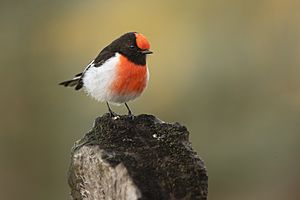
The red-capped robin lives all over Australia. You won't find them in Tasmania, Cape York, the Top End, or most of the Kimberley region. They do live on islands like Rottnest Island, Greenly Island, and Pearson Island off the Eyre Peninsula. However, they are not found on Kangaroo Island.
Even though they are found in many places, they are not common everywhere. They are rare east of the Great Dividing Range and in coastal areas in the south. They are also rarely seen north of 20°S latitude. We don't know much about how they move around, especially when it's not breeding season. In the southern parts of their range, they tend to stay in one place. But they visit the Nullarbor Plain and Adelaide region in South Australia, and central Victoria in spring and summer. In the northern parts of their range, they are winter visitors.
Preferred Habitat
The red-capped robin likes drier places than its relatives. It lives in dry Acacia, Callitris, or mixed scrubland and woodland. These areas often have trees like mulga (Acacia aneura), Georgina gidgee (Acacia georginae), and different types of cypress-pine. The ground usually has shrubs like Cassinia, hop-bush (Dodonaea), emu bush (Eremophila), and spinifex (Triodia).
Dangers and Threats
Human changes to the land have not been good for the red-capped robin. It used to be common in Sydney's western suburbs, but now it has almost disappeared from the Sydney Basin. It has also vanished from near Rockhampton in Queensland. Its numbers have gone down on Rottnest Island and in the Wheatbelt region of Western Australia. Studies show that they don't survive as well in small areas of remaining natural land.
Wild cats are known to hunt red-capped robins. Other birds, like the Australian raven, grey shrike-thrush, grey butcherbird, and white-browed babbler, raid their nests and take young birds. There is also one record of a brown-headed honeyeater eating an egg. Predators are the most common reason why nests fail.
Behavior and Life
Red-capped robins are usually seen alone or in pairs. Sometimes, in autumn and winter, you might see groups of up to eight birds. These groups are usually a mated pair and their young. They might also join groups of other small insect-eating birds. These can include the willie wagtail, southern whiteface, rufous whistler, and black-faced woodswallow.
Daily Habits
The red-capped robin often sits on a low branch or rock where it can be easily seen. It frequently flicks its wings and tail. This bird is very active and doesn't stay still for long. Females are often quite calm around people, but males are more careful.
Territory and Defense
During the breeding season, red-capped robins protect their territory. This area can be between 0.25 and 1.2 hectares (0.6 to 3 acres). A pair will live and find food within their territory before moving away in autumn. The male sings loudly from a good spot at the edge of his territory to show it's his. If another male tries to enter, he will make a harsh scolding call. Males have been seen facing each other, flicking their wings, and trying to get a better position in a warning display. Both males and females also react to recordings of their songs. The male will also defend his territory from male scarlet robins.
Most young red-capped robins cannot live in areas already taken by adult birds. They have to travel to find new, empty land. The longest distance a young robin has been recorded traveling is 36 kilometers (22 miles).
Reproduction and Life Cycle
The breeding season for red-capped robins lasts for five months, from August to January. During this time, they can raise up to three groups of young. The male robin suggests good places for a nest to the female. He does this by rubbing his body over a suitable tree fork while making a continuous trilling sound. He might show her several spots before the female chooses where to build. She then builds the nest by herself.
The nest is a neat, deep cup made of soft, dry grass and bark. They use Spider webs, feathers, and fur to hold it together or fill it. The nest is usually placed in a tree fork or sometimes in a mistletoe bush. They might decorate it with lichen to help it blend in with its surroundings.
The female lays two to three dull white eggs that might have a bluish, grayish, or brownish tint. These eggs also have dark grey-brown spots. Each egg is about 16 by 13 millimeters (0.63 by 0.51 inches). The female alone sits on the eggs to keep them warm, but both parents feed the young. The male will watch over the nest or perch nearby while the female is looking for food. Both parents feed the young quickly if there are predators nearby.
It's quite common for young to have a different father than the one raising them. About 23% of nestlings and 37% of broods (groups of young) have a different father. There is some evidence that these extra pairings are more likely to produce male birds.
Like all songbirds, the chicks are born helpless. They are blind and only have a thin layer of down. By seven days old, they start stretching their wings. At two weeks, they can fly. Parents feed their young for at least three weeks after they leave the nest. They have been seen giving them spiders and insects like flies and moths. Males take over feeding the young when females start building a new nest for the next group of chicks.
The long breeding season and raising multiple groups of young help them survive in a mild climate with many predators. Even with this, on average, only two young birds successfully leave the nest each year.
Some cuckoos, like the brush cuckoo, pallid cuckoo, Horsfield's bronze cuckoo, and black-eared cuckoo, are brood parasites of the red-capped robin. This means female cuckoos lay their eggs in robin nests, and the robins then raise the cuckoo chicks as their own. However, red-capped robins have been seen aggressively chasing Horsfield's bronze-cuckoos away from their territories.
What Do They Eat?
The red-capped robin mainly eats insects and other small arthropods (creepy crawlies). One study of their droppings in Western Australia showed that 96% of their diet was made up of beetles, and the rest were ants. Other foods they eat include spiders, grasshoppers (like the Australian plague locust), butterflies and moths (both adults and larvae), dragonflies and damselflies, mantises, antlions, true bugs (like chinch bugs and shield bugs), earwigs, and flies (like blow-flies and horse-flies).
The red-capped robin usually pounces on its prey on the ground. However, it can also swoop down and catch flying insects in the air. Less often, it will pick prey from low plants, almost always less than 3 meters (10 feet) above the ground. The prey is most often on the ground when caught. They might use a low branch as a good spot to watch for food.
Images for kids
-
Red-capped Robin in New South Wales
See also
 In Spanish: Petroica frentirroja para niños
In Spanish: Petroica frentirroja para niños



